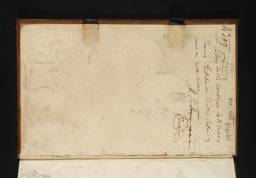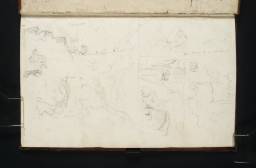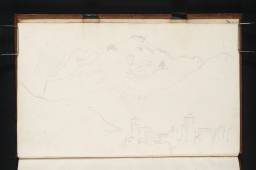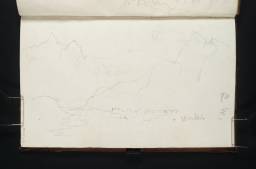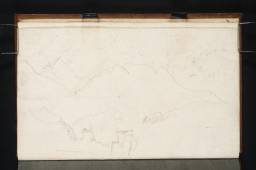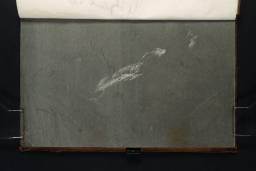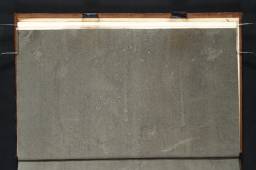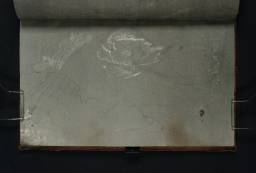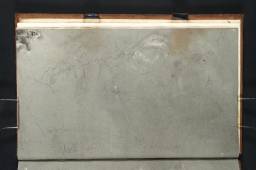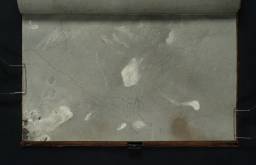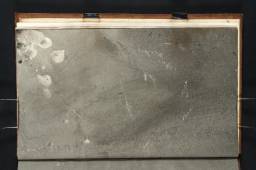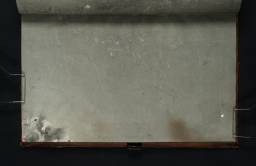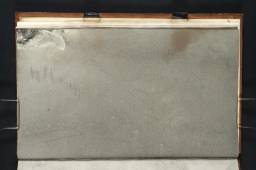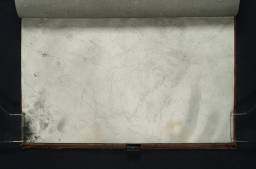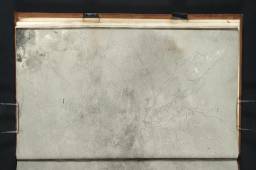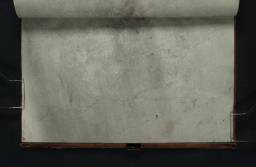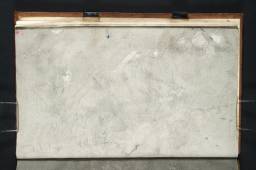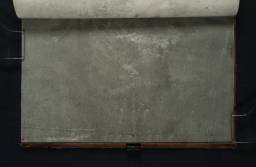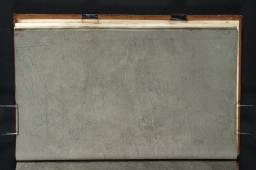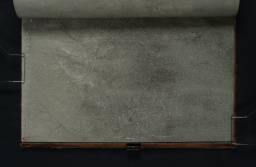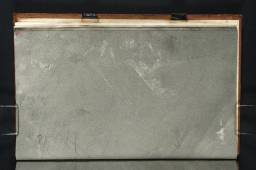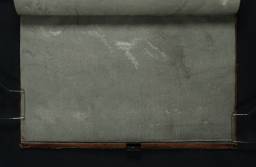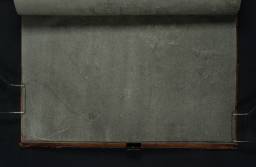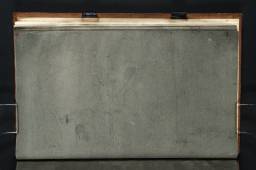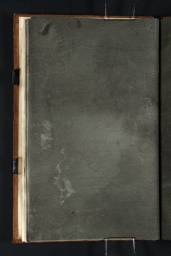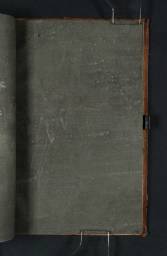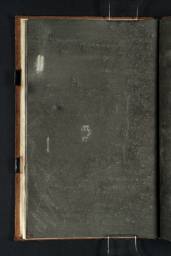Turner Bequest CXCIV
Brown leatherbound sketchbook with gold tooling on boards and spine
43 leaves of white wove writing paper, approximate page size 195 x 121 mm
Made by William Balston, Springfield Mill, Maidstone, Kent; various pages watermarked ‘J WHATMAN | 1814’ and ‘2 | 1817’
43 leaves of white wove writing paper, approximate page size 195 x 121 mm
Made by William Balston, Springfield Mill, Maidstone, Kent; various pages watermarked ‘J WHATMAN | 1814’ and ‘2 | 1817’
Inscribed by the artist in black ink ‘17 Passage of Simplon’ on paper label on spine (D40958)
Stamped in black ‘CXCIV’ top right of front cover
Stamped in black ‘CXCIV’ top right of front cover
Inside front cover inscribed by Henry Scott Trimmer in black ink ‘No–189 [as part of the Turner Schedule in 1854] | This book contains 40 leaves | Pencil sketches on Tinted Papers | some on both sides | H.S. Trimmer | C. Turner’ and initialled in pencil by Charles Lock Eastlake ‘C.L.E.’ and John Prescott Knight, ‘JPK’ descending right-hand edge (see D40959)
Accepted by the nation as part of the Turner Bequest 1856
References
Turner used this sketchbook during his first tour of Italy in 1819, one of twenty-three related to that trip. The book is so titled, ‘Passage of the Simplon’ after the artist’s own label. For many years it was only tentatively connected with Turner’s Italian tour since it was clear that the artist arrived and departed Italy via the Mont Cenis Pass, not the Simplon Pass.1 However, as Cecilia Powell first correctly suggested, the book records a diversionary expedition into the Swiss Alps from the Italian Lakes, and contains sketches of the dramatic mountainous landscape, many of them executed on paper prepared with a grey watercolour wash.2 There are also a handful of views of the Borromean Islands on Lake Maggiore.
The itinerary for this part of Turner’s Italian tour is established by a sequence of topographical sketches which lead directly from the end of the Turin, Como, Lugarno, Maggiore sketchbook (Tate; Turner Bequest CLXXIV) to the beginning of the Passage of the Simplon sketchbook. After crossing the Pass of Mont Cenis into Italy the artist travelled to Turin and Milan, before taking a tour around the Italian Lakes (Como, Lugano and Maggiore). From Baveno on Lake Maggiore he then struck north following the course of the River Toce to Vogogna and Domodossola before turning west into the Val Divedro at Crevoladossola. Between Iselle and Gondo he crossed the border from Italy into Switzerland and followed the route towards the Simplon Pass through the Gondoschlucht (Gondo Ravine) and the village of Simplon-dorf, a road then only recently constructed by Napoleon between 1800 and 1805. According to Mariana Starke, who journeyed through the Simplon Pass twice in May 1817 and June 1819, the ascent from Domodossola to the village of Simplon-dorf could be accomplished in seven hours, whilst the descent took five and a half hours.3 It is not clear from the existing sketches whether Turner climbed all the way to the Simplon Pass itself but he certainly does not appear to have made it as far north as Brig, generally considered to be the start (or end) of the Napoleonic road through the mountains. Having reached his intended destination Turner then retraced his steps to Domodossola and Baveno, before continuing south along the western shores of Lake Maggiore to Milan and eventually journeying onwards to Venice (see the Milan to Venice sketchbook, Tate; Turner Bequest CLXXV).
Turner’s brief expedition to the Simplon Pass was an unusual deviation from the traditional nineteenth-century routes through Italy, and was an Alpine experience more usually incorporated within the outward or return journey to or from Italy via Switzerland. James Hakewill (1778–1843), for example, had travelled to Italy via Geneva and the Simplon Pass, and had advised Turner to take this road in the Route to Rome sketchbook (see Tate D13861 and D13862; Turner Bequest CLXXI 2 and 3). He recommended that his friend ‘Go leisurely over the Mountain’ since ‘The descent on the Italian side [is] the finest’.4 Turner subsequently chose to enter Italy via France and the Pass of Mont Cenis but may have been inspired to visit the Simplon Pass by Hakewill’s enthusiasm for the landscape. He may even have seen Hakewill’s own drawings of the scenery during their recent collaboration on the topographical publication, Picturesque Tour of Italy, published 1820.5 Turner’s biographer, Walter Thornbury, also recorded an anecdotal story about the artist once meeting his friend and patron Walter Fawkes in the area of the Simplon pass.6 If true, Fawkes’s presence could also explain Turner’s unorthodox detour at this point in his travels. Furthermore, the Simplon is listed amidst the possible subjects for watercolours for Fawkes in the Paris, Seine and Dieppe sketchbook, 1821 (see Tate D18540; Turner Bequest CCXI 10). Ultimately Turner chose not to use it as a theme at this time, and it was not until around 1833 that he eventually completed a painting based upon his experiences and sketches, The Simplon,7 a watercolour vignette which was engraved and published in Scott’s Prose Works, 1834–6 (see Tate T04743).8
The majority of views in the Passage of the Simplon sketchbook are executed in pencil on grey watercolour wash with small areas of white scratching or lifting out. Turner clearly felt that the dark ground provided a suitable tonal background against which to record the dramatic Alpine landscape, comparable to his 1802 drawings in the Grenoble and St Gothard and Mont Blanc sketchbooks (both Tate; Turner Bequest LXXIV and LXXV). He also used a similar treatment for certain subjects within the Tivoli sketchbook (Tate; Turner Bequest CLXXXIII), the Naples; Rome C. Studies sketchbook (Tate; Turner Bequest CLXXXVII), the Rome C. Studies sketchbook (Tate; Turner Bequest CLXXXIX), and the Small Roman C. Studies sketchbook (Tate; Turner Bequest CXC). However, in this instance, the combination of faint pencil marks and the dark, uneven quality of the grey ground makes the sketches difficult or even virtually impossible to see. John Ruskin described it as a ‘Careless Book’.9
Mariana Starke, Travels on the Continent written for the Use and Particular Information of Travellers, London 1820, p.82.
See Tony Cubberley and Luke Herrmann, Twilight of the Grand Tour: A Catalogue of the drawings by James Hakewill in the British School at Rome Library, Rome 1992, nos.1.35–1.37, pp.109–11.
Walter Thornbury, The Life of J.M.W. Turner, R.A., London 1862, vol.2, pp.88–9. See Powell 1984, p.69.
Technical notes
How to cite
Nicola Moorby, ‘Passage of the Simplon sketchbook 1819’, sketchbook, May 2011, in David Blayney Brown (ed.), J.M.W. Turner: Sketchbooks, Drawings and Watercolours, Tate Research Publication, December 2012, https://www

